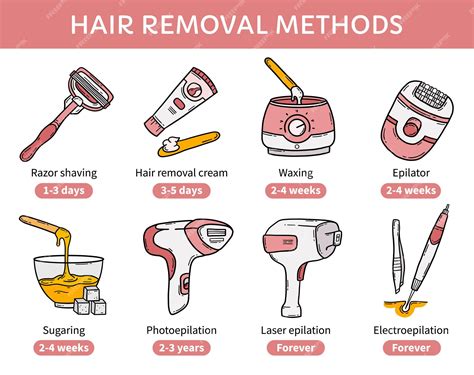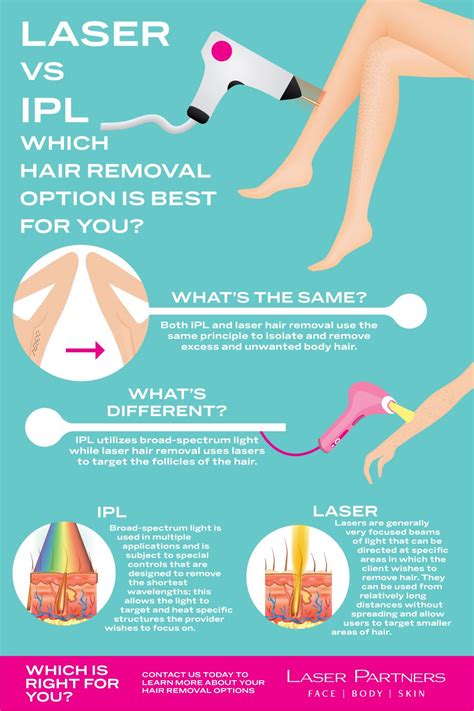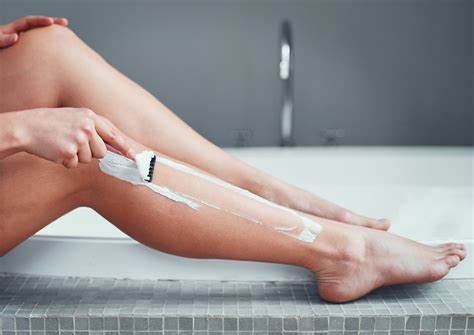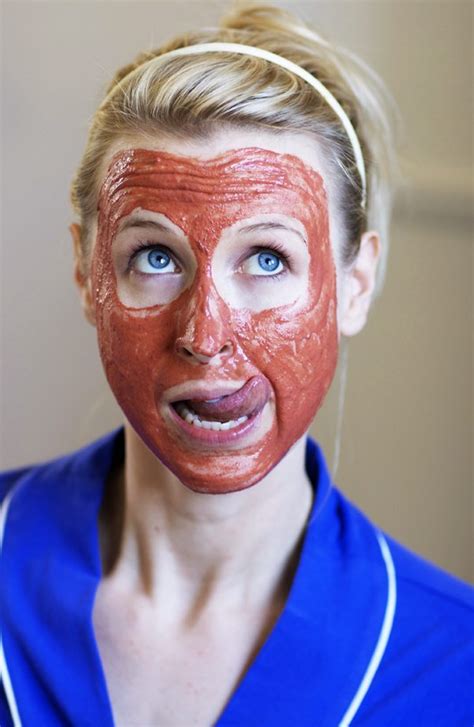Are you tired of dealing with unwanted hair? Do you long for the sensation of silky, flawless skin against your fingertips? Look no further, for we have the solution to your dreams right here.
Embark on a journey towards attaining the ultimate sensation of smoothness with the ancient art of hair removal. Explore the myriad of possibilities that exist to achieve a hair-free existence, and unlock the secret to supple skin that will leave you feeling confident and beautiful.
With a cornucopia of methods at your disposal, our comprehensive guide will take you through the various techniques available today. From traditional practices handed down through generations to cutting-edge technological advancements, there is an option tailored to suit your unique preferences and needs. Whether you seek a quick and convenient fix or crave a longer-lasting solution, we've got you covered.
Prepare to be captivated by the delicate dance between science and self-care as we delve into the history, benefits, and potential pitfalls of each hair removal method. Discover how ancient civilizations honed their techniques to achieve unparalleled smoothness, and how modern science has revolutionized the art of hair removal to make it more accessible and comfortable than ever before. Unmask the mystery behind each method as we reveal the mechanisms at work, demystify misconceptions, and provide practical tips for optimal results.
The Evolution of Hair Removal Techniques

Throughout history, humans have employed various methods to remove unwanted hair from their bodies. Over time, as society's standards and preferences have changed, so too have the techniques used for hair removal. This section explores the evolution of these techniques, highlighting how they have progressed and adapted to meet the demands of different eras.
- Ancient Times: In ancient civilizations, individuals utilized primitive methods to achieve hair-free skin. These methods often involved using basic tools such as seashells, stones, and even sharp rocks to scrape away unwanted hair.
- Early Innovations: As societies advanced, new hair removal techniques emerged. During the Middle Ages, for example, people turned to threading, a method still popular in some regions today, where a thread is twisted and rolled across the skin to remove hair from its roots.
- The Rise of Shaving: With the advent of metalworking and the development of sharper blades, shaving became a widely practiced hair removal method. This technique gained popularity among both men and women and remains a common practice today.
- Chemical Solutions: During the Renaissance era, the use of depilatory creams and pastes gained popularity. These solutions were made from ingredients such as arsenic, quicklime, and sulfur, which dissolved the hair at the skin's surface.
- Modern Innovations: In the 20th century, technological advancements revolutionized the hair removal industry. Electric razors, waxing, and electrolysis emerged as popular choices, offering more efficient and longer-lasting results.
- Laser and Intense Pulsed Light (IPL): As technology continued to progress, the introduction of laser and IPL treatments brought a new level of precision and permanence to hair removal. These methods target the hair follicle, effectively reducing hair growth over time.
From primitive scraping tools to sophisticated laser technologies, the evolution of hair removal techniques reflects our desire for smooth and hair-free skin. As society continues to evolve, it is likely that new innovations will emerge, further enhancing the effectiveness and accessibility of hair removal methods.
From Ancient Times to the Modern Age
In the realm of personal grooming, there has always been a timeless desire for smoothness and hair-free skin. Throughout history, individuals have sought various methods to achieve this desired state. From ancient civilizations to the modern age, the quest for smooth skin has evolved and transformed, giving birth to a multitude of techniques and practices.
Throughout history, people have employed diverse means to address the challenge of unwanted hair. In past eras, traditional techniques such as threading and plucking were commonly utilized to remove hair from different parts of the body. The ancient Egyptians, for example, used tweezers made from seashells to meticulously remove hair. Meanwhile, in ancient India, the practice of threading involved the use of cotton thread to extract hair at the root.
In more recent times, advancements in technology have revolutionized the world of hair removal. The advent of electricity in the 19th century introduced innovative techniques like electrolysis, which utilized a small electric current to permanently remove hair. This marked a significant departure from the manual methods of the past.
Advancements in the 20th century further propelled the quest for smooth skin. The invention of shaving razors brought about a convenient and efficient way to temporarily remove hair. Additionally, the development of waxing techniques offered longer-lasting results by removing hair from the root.
In the modern age, technological advancements have given rise to non-invasive methods such as laser hair removal. This revolutionary approach utilizes laser technology to target and disrupt hair follicles, resulting in long-term reduction of hair growth. Furthermore, methods like intense pulsed light (IPL) have emerged as popular alternatives to achieve smooth skin without the need for repeated treatments.
From ancient times to the modern age, the pursuit of hair removal has stood the test of time, constantly evolving to meet the ever-changing needs and preferences of individuals. As technology continues to advance, it is likely that new and more efficient methods will emerge, generating further excitement and possibilities in the quest for smooth and hair-free skin.
Exploring the Advantages and Disadvantages of Various Hair Removal Techniques

In this section, we will delve into the pros and cons of diverse methods for eliminating unwanted hair from various parts of the body. By examining the different options available, you can make an informed decision based on your personal preferences and needs.
| Method | Advantages | Disadvantages |
|---|---|---|
| Shaving | Quick and easy process | Temporary results; requires frequent maintenance |
| Waxing | Longer-lasting results; hair grows back finer | Potential pain and discomfort; can cause skin irritation |
| Laser Hair Removal | Permanent reduction in hair growth | Expensive; multiple sessions may be required; not suitable for all skin and hair types |
| Depilatory Creams | Quick and painless; no stubble | Strong chemical odor; may irritate sensitive skin; results may not last long |
| Electrolysis | Permanent hair removal option | Time-consuming process; can be uncomfortable; expensive |
| Sugaring | Natural and eco-friendly option | Not widely available; can be messy; technique may require practice |
By considering the advantages and disadvantages of each hair removal method, you can select the one that aligns with your preferences, comfort level, and desired results. Keep in mind that what works for one person may not work for another, and it's important to choose a method that suits your specific needs and lifestyle.
Which Approach is Right for You?
Choosing the most suitable hair removal method can be a daunting task, as there are numerous options available to cater to different preferences and needs. In this section, we will explore various approaches that can help you achieve the desired results.
1. Waxing:
Waxing is a popular hair removal technique that involves applying a layer of wax on the skin and removing it quickly to extract the hair from the root. This approach offers longer-lasting results compared to shaving, as it removes hair from the follicle, resulting in a smoother appearance. However, keep in mind that waxing can be painful, especially for those with sensitive skin.
2. Depilatory Creams:
Depilatory creams contain chemicals that dissolve the protein structure in the hair, making it easy to wipe away. This method is relatively painless and convenient, as it can be done in the comfort of your own home. However, the results may not last as long as waxing, and some individuals may experience skin irritation or allergies to the chemicals used.
3. Laser Hair Removal:
Laser hair removal is a popular option for those seeking a more permanent solution. This technique uses high-intensity light pulses to target and destroy hair follicles, reducing hair growth over time. It is important to note that laser hair removal may require multiple sessions to achieve the desired outcome and is generally most effective on individuals with darker hair and lighter skin tones.
4. Epilators:
Epilators are handheld devices that mechanically remove hair from the root. These devices work by grasping and pulling out multiple hairs simultaneously using rotating tweezers. They are cost-effective and provide results similar to waxing, but they can be painful and may cause skin irritation for some individuals.
5. Electrolysis:
Electrolysis is a permanent hair removal method that involves the use of a fine needle inserted into each hair follicle. An electric current is then applied to destroy the hair roots. While this approach can be time-consuming and expensive, it is highly effective in permanently reducing hair growth. Electrolysis is suitable for all skin and hair types and can be a great option for those seeking long-lasting and permanent results.
Before deciding on a hair removal approach, it is essential to consider factors such as pain tolerance, budget, skin sensitivity, and desired results. Consulting with a professional or dermatologist can also provide valuable insights to help you make an informed decision tailored to your specific needs.
Disclaimer: Please note that while the information provided here can serve as a general guide, it is important to consult with a professional before undergoing any hair removal treatments to ensure safety and efficiency.
Unveiling the Truth About Laser Hair Elimination

Discover the hidden secrets behind the revolutionary technique of laser hair elimination, as we delve into the science and myths surrounding this popular beauty treatment.
When it comes to getting rid of unwanted hair, laser hair elimination has become a buzzword in the beauty industry. This innovative method claims to offer a long-lasting solution to hair removal, using advanced technology to target hair follicles and inhibit their growth. But what is the truth behind the hype? Let's separate fact from fiction and explore the world of laser hair elimination.
One of the common misconceptions about laser hair elimination is that it is a quick-fix solution for smooth skin overnight. However, the reality is that this process requires multiple sessions to achieve desired results. Laser hair elimination works by emitting a concentrated beam of light onto the skin, targeting the melanin in the hair follicles. As the light is absorbed, it converts into heat, damaging the hair follicles and inhibiting their ability to produce new hair. But since hair growth occurs in cycles, several sessions are needed to ensure that all hair follicles are effectively treated.
| Myth | Fact |
|---|---|
| Laser hair elimination is painful | Laser hair elimination can cause some discomfort, but it is generally well-tolerated by most individuals. Advances in technology have also made the procedure more comfortable than ever before. |
| Laser hair elimination works on all skin types and hair colors | The effectiveness of laser hair elimination can vary depending on the individual's skin type and hair color. Dark hair and light skin tend to yield the best results, but advancements in technology have made it possible to treat a wider range of skin tones and hair colors. |
| Laser hair elimination is permanent | Laser hair elimination offers long-term hair reduction, but it may not permanently eliminate all hair. Maintenance sessions may be required to ensure lasting results. |
It is important to consult with a qualified professional before undergoing laser hair elimination, as they can assess your unique circumstances and recommend the most suitable treatment plan based on your skin type, hair color, and desired outcome. By uncovering the truth about laser hair elimination, you can make an informed decision and embark on your journey to smooth, hair-free skin.
Is it Safe and Effective for Everyone?
In the world of beauty and personal grooming, there is a desire among individuals to achieve smooth and hair-free skin. However, it is essential to carefully evaluate the safety and effectiveness of hair removal methods before deciding on a particular solution. This section aims to delve into the question of whether hair removal treatments are suitable for all individuals, ensuring the focus remains on providing reliable information without using specific terms.
To comprehensively understand the safety and effectiveness of hair removal, it is crucial to consider various factors. These factors include the individual's skin type, sensitivity, and any underlying medical conditions. Certain hair removal techniques may be more suitable for those with specific skin types, while others might be more effective in different scenarios. It is essential to conduct research and consult with professionals to determine the best hair removal method for each individual.
| Safety | Effectiveness |
|---|---|
| When it comes to safety, it is vital to consider the potential risks and side effects associated with different hair removal methods. Some techniques may cause skin irritation, redness, or even burns if not performed correctly or if the individual has a particular sensitivity. Understanding these risks and taking appropriate precautions can contribute to a safer hair removal experience. | The effectiveness of hair removal methods can vary based on various factors, including hair thickness, color, and growth rate. Certain techniques may be more effective for individuals with specific hair characteristics, while others may yield better results for a broader range of individuals. Considering one's unique hair traits can aid in selecting the most effective approach. |
| Additionally, it is essential to manage expectations regarding the effectiveness of hair removal treatments. While some methods can provide long-lasting results, others may require regular maintenance to sustain the desired outcome. Understanding the potential limitations and time commitment of each technique can help individuals make informed decisions about their hair removal journey. | Moreover, it must be noted that no hair removal method guarantees permanent results for everyone. Each individual's experience may vary, and it is essential to be realistic about the outcomes. Consulting with professionals and understanding the potential limitations of each method can help individuals set reasonable expectations and make informed choices regarding their hair removal journey. |
In conclusion, when considering hair removal techniques, one must take into account various factors such as individual characteristics, safety precautions, and expected effectiveness. By making informed decisions based on thorough research and professional guidance, individuals can minimize risks and maximize the benefits of their hair removal experience.
The Growing Trend of DIY Hair Removal: Insider Tips and Tricks

In recent years, a new trend has emerged in the realm of personal grooming - the rise of DIY hair removal. With an increasing number of individuals seeking alternative methods to achieve smooth and hair-free skin, the DIY approach has garnered noteworthy attention. This article aims to provide valuable insights and tips to those looking to embrace this trend and explore the world of at-home hair removal techniques.
How to Achieve Professional-Level Results in the Comfort of Your Home
Looking to achieve salon-quality results without leaving the house? With the right techniques and tools, you can achieve smooth and hair-free skin like a professional, without the need for expensive appointments or trips to the salon. In this section, we will explore various tips and tricks to help you get the flawless results you desire in the convenience of your own home.
Prepare Yourself:
Before you start your at-home hair removal routine, it's important to properly prepare yourself. This includes exfoliating the area to remove dead skin cells, ensuring a clean and smooth surface for hair removal. Additionally, it's recommended to trim longer hair beforehand to prevent any pulling or discomfort during the process.
Select the Right Method:
There are several different methods available for at-home hair removal, each with its own pros and cons. Whether you opt for waxing, sugaring, epilating, or using a depilatory cream, it's essential to choose the method that best suits your preferences and skin type. Experimenting with different techniques may be necessary to find the one that works best for you.
Invest in Quality Products:
While at-home hair removal may seem like a budget-friendly alternative to salon treatments, investing in high-quality products can make a significant difference in the results you achieve. Look for reputable brands that offer products specifically designed for at-home use, ensuring they are safe and effective.
Follow Proper Technique:
Proper technique plays a crucial role in achieving salon-quality results. Whether you're waxing, sugaring, or using an epilator, it's important to follow the instructions carefully and maintain a steady hand. Additionally, using a soothing lotion or gel after hair removal can help reduce any potential redness or irritation.
Maintain Consistency:
Consistency is key when it comes to at-home hair removal. To achieve long-lasting smoothness, it's important to establish a regular routine and stick to it. Depending on the method you choose, you may need to repeat the process every few weeks for optimal results. With time and practice, you'll become more proficient and achieve salon-worthy results with ease.
By following these tips and guidelines, you can achieve salon-quality hair removal results in the comfort and privacy of your own home. Remember to prioritize proper preparation, select the right method and products, follow correct technique, and maintain a consistent routine to enjoy smooth and hair-free skin all year round.
Comparing Waxing and Shaving: Which Method Provides Longer-lasting Results?

In the pursuit of smooth and hair-free skin, individuals often turn to various hair removal methods. Two popular options, waxing and shaving, are frequently compared for their efficiency and duration of results. This section aims to analyze and weigh the advantages and disadvantages of both methods, focusing on their respective durations.
Waxing: This technique involves the application of a layer of warm or cold wax onto the skin, followed by the removal of the wax along with the unwanted hair. One of the primary benefits of waxing is that it removes hair from the root, resulting in smoother skin that lasts longer than other methods. Waxing has the potential to provide several weeks of hair-free skin, resulting in minimal maintenance.
However, it's important to note that waxing can be uncomfortable, particularly for those with sensitive skin. Additionally, the process can be time-consuming, requiring a visit to a professional salon or a considerable amount of DIY effort.
Shaving: This method involves using a razor or electric shaver to cut the hair at the skin's surface. While shaving is a convenient and quick option, the results tend to be temporary. The hair typically regrows within a few days to a week, requiring frequent maintenance to maintain smoothness.
Although shaving can be easily integrated into one's daily routine, the regrowth of hair can lead to potential skin irritation, ingrown hairs, and a less smooth appearance compared to waxing.
Ultimately, the decision between waxing and shaving depends on individual preferences and circumstances. Those seeking longer-lasting results and willing to endure a potentially uncomfortable process may find waxing to be a suitable option. Conversely, individuals looking for a quick and easily accessible method may prefer shaving, despite the need for more frequent touch-ups.
A Comparison for the Time-Conscious Individual
For those who value their time and seek efficient solutions, it's crucial to compare different options when it comes to achieving long-lasting hair-free results. This section aims to provide insights into various methods of hair removal available, allowing individuals to make informed decisions based on their specific needs and desired outcomes.
Option 1: Laser Hair Removal
Laser hair removal offers a fast and effective solution for those looking to minimize time spent on hair removal routines. By utilizing modern technology, laser treatments target hair follicles, rendering them unable to produce new hair growth. With multiple sessions required for optimal results, individuals can gradually achieve reduced hair growth and enjoy smoother skin over time.
Option 2: Waxing
Waxing is a popular choice for those seeking longer-lasting results without the commitment of laser treatments. This method involves the application of hot wax onto the skin, which adheres to the hair and is then swiftly removed, pulling the hair out from the root. Although waxing can be a slightly more time-consuming option, it offers the benefit of hair-free skin for several weeks.
Option 3: Depilatory Creams
Depilatory creams provide a quick and convenient alternative for individuals with busy schedules. These creams contain chemical compounds that dissolve the hair at the surface level, allowing for effortless removal. While depilatory creams provide immediate results, hair regrowth tends to be faster compared to other methods, requiring more frequent applications to maintain smooth skin.
Option 4: Epilators
Epilators offer a time-efficient solution by mechanically removing hair from the root. These handheld devices use rotating tweezers to grasp and pull out multiple hairs simultaneously, providing longer-lasting results compared to shaving. Although epilating can be initially uncomfortable, regular use can lead to finer hair regrowth and ultimately smoother skin over time.
Conclusion
When choosing a hair removal method, it's essential to consider individual preferences and time constraints. Laser hair removal and waxing offer more long-term solutions, while depilatory creams and epilators provide quick and convenient options. By understanding the pros and cons of each method, individuals can make a well-informed decision and achieve hair-free, smooth skin that suits their lifestyle and time commitments.
Understanding the Psychology Behind the Fascination with Smooth and Hairless Skin

Human beings have long been captivated by the allure of achieving flawlessly smooth and hairless skin. This deep-rooted fascination can be attributed to various psychological factors that drive individuals to desire a hair-free body. It is important to explore the underlying motivations and understand the psychology behind this pervasive desire.
Firstly, the quest for hairless skin can be attributed to societal standards of beauty and cultural ideals. From ancient civilizations to modern times, a hairless body has often been associated with notions of cleanliness, youthfulness, and attractiveness. As a result, many individuals feel pressure to conform to these beauty standards and believe that removing hair will enhance their physical appearance and boost their self-confidence.
Moreover, the desire for hairless skin stems from psychological associations with notions of femininity and masculinity. In many societies, women are often expected to have smooth and hair-free skin, while men are often encouraged to be naturally hairy. This societal norm reinforces gender roles and expectations, leading individuals to perceive hair removal as a way to conform to traditional ideals of femininity or masculinity.
Furthermore, the psychological aspect of self-care plays a significant role in the desire for hairless skin. Engaging in grooming rituals, such as hair removal, allows individuals to take control of their physical appearance and engage in self-enhancement activities. The process of removing unwanted hair can provide a sense of empowerment, self-care, and personal satisfaction, thereby influencing the psychological well-being of individuals.
Lastly, the desire for hairless skin can be influenced by personal experiences and associations with emotional well-being. Some individuals may have had negative experiences related to body hair, such as being teased or feeling self-conscious, which can instill a strong desire for hair removal. These emotional associations can be deeply ingrained and contribute to the psychological drive to achieve smooth and hair-free skin.
- In conclusion, the psychology behind the desire for hairless skin is multifaceted and encompasses societal standards of beauty, gender expectations, self-care, and personal experiences. Understanding these psychological factors can shed light on the profound fascination with achieving flawlessly smooth and hair-free skin.
Exploring the Emotional Effects of Hair Removal
In this section, we will delve into the profound emotional impact that the process of eliminating unwanted hair can have on individuals. Beyond the physical aspect, hair removal can stir up a range of emotions, influencing self-image, self-esteem, and even mental well-being.
For many, the decision to remove hair stems from a desire to conform to societal beauty standards and achieve a preferred aesthetic. However, this pursuit of societal norms can lead to feelings of insecurity and inadequacy when one fails to meet these expectations. Hair removal then becomes a way to regain control over one's appearance and boost confidence.
The emotional ramifications of hair removal extend beyond societal pressures. Individuals may experience a sense of liberation and empowerment when they eliminate unwanted hair, feeling more in tune with their own identity and personal choices. It can serve as a form of self-care, allowing individuals to prioritize their own comfort and well-being.
| Emotional Effects of Hair Removal |
|---|
| Boosts self-confidence |
| Creates a sense of control over appearance |
| Enhances self-image |
| Provides a feeling of liberation |
| Promotes self-care and well-being |
On the other hand, hair removal can also have negative emotional effects, particularly if it becomes an obsession or source of anxiety. The pressure to maintain hair-free skin can lead to a constant preoccupation with one's appearance, fostering self-doubt and dissatisfaction. It is important to strike a balance between personal preferences and the emotional impact of hair removal.
Understanding the emotional effects of hair removal is crucial in fostering a more compassionate and inclusive approach towards body hair. Recognizing that the decision to remove or retain hair is deeply personal and influenced by various factors can help promote acceptance and celebrate individual choices.
In conclusion, exploring the emotional aspects of hair removal sheds light on the nuanced impact it has on individuals. By acknowledging and understanding these effects, we can create a more supportive environment that values diverse perspectives and empowers individuals to make choices that align with their own emotions, desires, and well-being.
FAQ
Is hair removal a permanent solution for smooth skin?
Hair removal methods like laser hair removal can provide long-term reduction in hair growth, but it is not typically considered a permanent solution. It may require multiple sessions to achieve the desired results and occasional maintenance treatments.
What are some popular methods of hair removal?
Some popular methods of hair removal include shaving, waxing, plucking, depilatory creams, and laser hair removal. Each method has its own pros and cons, so it is important to choose the one that suits your preferences and needs.
Does hair regrow thicker after shaving?
No, shaving does not make hair grow back thicker. When you shave, you are simply cutting the hair at the surface of the skin, so it may appear coarser or stubbly as it grows back. However, the thickness and color of the hair remain unchanged.
Are there any side effects of laser hair removal?
Although laser hair removal is generally considered safe, there can be some potential side effects. These may include temporary redness, swelling, or skin irritation in the treated area. It is important to consult with a professional and follow their instructions for pre and post-treatment care to minimize any risks.



